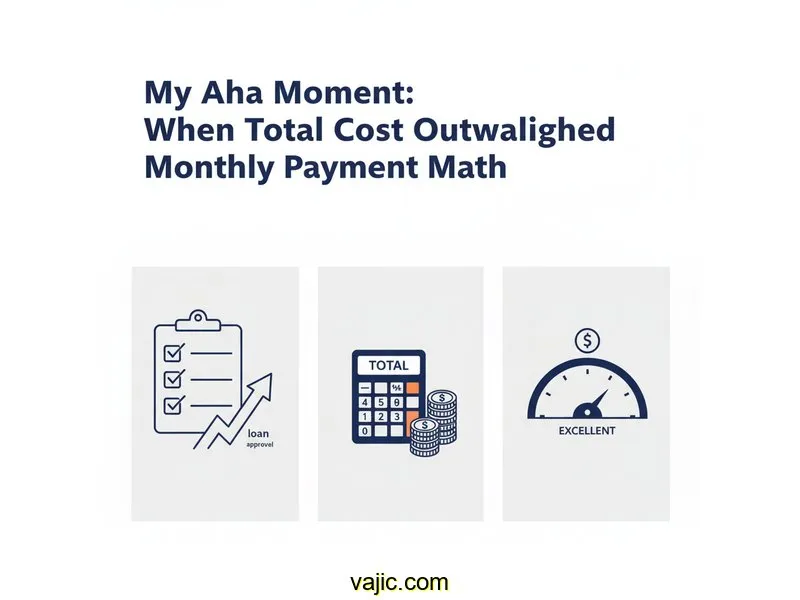
Auto Loan Calculator
Calculate payments over the life of your Loan
Home Blog Privacy Terms About Contact
Calculate payments over the life of your Loan
Home Blog Privacy Terms About ContactPublished on October 13, 2025

My journey into the world of loan calculations started with a simple, confusing conversation over coffee. My friend mentioned their monthly payment for a recent personal loan, and the number seemed surprisingly low. We had borrowed similar amounts, and I knew our credit profiles were in the same ballpark. Yet, their payment was nearly a hundred dollars less than what I was mentally calculating for my own potential loan. How was that possible?
For a moment, I felt a pang of… something. Was I missing a secret? Did they find some amazing deal? But then, my curiosity took over. It wasn't about getting a "better" deal; it was about understanding the math that could produce such different outcomes from similar starting points. What lever were they pulling that I didn't even know existed? This single question sent me down a rabbit hole, not of finding a loan, but of understanding how loan calculators actually work.
My initial attempts were clumsy. I'd go to an online calculator, plug in a loan amount and an interest rate, and stare at the resulting monthly payment. To me, that single number was the answer. It was the finish line. If that number was low, the loan was "good." If it was high, it was "bad." I didn't yet realize that I was reading the last page of a book without knowing any of the characters or the plot. The real story, I was about to find out, was hidden in the other fields—the ones I had been completely ignoring.
This entire process became a personal challenge. I wanted to demystify the numbers for myself, to build the confidence that comes from genuine understanding. It’s important to state upfront: this is my personal story of learning how the calculations work. It is absolutely not financial advice. My goal is simply to share the steps of my journey and the "aha moments" that helped me connect the dots.
Armed with a mission, I decided to run a controlled experiment. I wanted to see exactly how changing just one variable could impact the outcome. I picked a hypothetical loan amount—a nice, specific number like $18,450—and a sample interest rate of 7.8%. My goal was to replicate the situation my friend described: a lower monthly payment.
First, I plugged in the numbers with a 48-month term (4 years). The calculator whirred for a millisecond and presented the result: $452.92 per month. "Okay," I thought, "that's my baseline." It was a clear, solid number.
Next, I changed only one thing: the loan term. I extended it to 72 months (6 years), keeping the $18,450 loan amount and 7.8% interest rate exactly the same. The new result popped up: $317.91 per month. My eyes widened. That was it! That was the magic trick. It was a difference of over $135 every single month. My initial, gut reaction was one of triumph. "See? A longer loan is cheaper!" I declared to my empty room. It felt so simple, so obvious.
But a nagging feeling crept in. It felt too easy. How could stretching out the same amount of money with the same interest rate result in a "cheaper" outcome? It defied a basic sense of logic. Nothing is free, right? I was so fixated on that monthly payment figure that I couldn't see the rest of the puzzle. I kept toggling the term back and forth between 48 and 72 months, watching the monthly payment number jump up and down. I was stuck in a loop, convinced that this one number told the entire story when, in reality, it was only the first chapter.
The breakthrough came from a place of pure frustration. Convinced I was missing something, I started clicking every button and link on the calculator's results page. I saw a small link that said, "Show full report" or "View amortization schedule." I clicked it, and the screen expanded to reveal a wealth of new information. There were charts, graphs, and two numbers that I had previously scrolled right past: "Total Interest Paid" and "Total of All Payments."
Suddenly, I felt like a detective who had just found a hidden clue. These weren't just secondary details; they were the main plot. I ran my two scenarios again, but this time, I ignored the monthly payment and focused only on these new fields. The story they told was completely different, and it was the "aha moment" I had been searching for.
The table made it all click into place. The lower monthly payment of the 72-month loan wasn't magic; it was a trade-off. I was trading a lower monthly bill for a significantly higher total cost over the life of the loan. The extra 24 months weren't free—they were 24 more months for interest to accumulate on the outstanding balance. The calculator wasn't giving me two different answers; it was showing me two different financial stories based on my inputs.
My key insight was realizing that an interest rate isn't a flat fee. It's a rate applied over time. By extending the time from 48 to 72 months, I was giving that 7.8% rate more time to work against me, generating over $1,149 in extra interest charges. Seeing that stark difference ($3,290.16 vs. $4,439.52) was what finally broke my fixation on the monthly payment. The true cost of borrowing wasn't the monthly bill; it was the total interest paid.
To make sure this wasn't a fluke, I started running more scenarios. I tried a $10,000 loan at 6.5%. I compared a 36-month term to a 60-month term. Every single time, the pattern held: the longer term offered a more attractive monthly payment, but the shorter term resulted in a lower total interest cost. I was no longer confused; I was empowered. I had learned how to read the language of the calculator.
After spending hours playing with different scenarios, I started to develop a personal checklist for how I approach loan calculators. This isn't advice on what to choose, but rather a guide to understanding what the numbers are actually telling you. My goal is always to get the most complete picture possible from the calculations.

After my deep dive, I finally understood. Their lower monthly payment was almost certainly because they chose a longer repayment term. While their monthly budget might feel less strained, the math shows they will likely pay significantly more in total interest over the life of their loan compared to someone with the same loan amount and rate but a shorter term.
I learned that there is no single "most important" number. They all work together. If your primary concern is fitting a payment into your monthly budget, the monthly payment figure is critical. If your concern is minimizing the cost of borrowing, the total interest paid is the number to watch. They simply answer different questions.
Because loan interest is typically calculated on the remaining principal balance each month (this is known as amortization). With a longer term, the principal balance decreases more slowly. This means that for more months, you are paying interest on a larger outstanding balance, which allows more total interest to accumulate over time.
For educational purposes like my own, these calculators are fantastic. They use standard, well-established mathematical formulas to generate their estimates. However, for an actual loan offer, the lender's official loan disclosure documents are the source of truth. Calculators are for understanding concepts; official documents are for financial commitments.
My journey started with a simple question born from a casual conversation, but it ended with a profound sense of clarity. The feeling of being confused by financial math has been replaced by a feeling of confidence. I no longer see a loan calculator as a magic box that spits out an answer; I see it as a tool for exploring possibilities and understanding the mechanics of how loans work.
The biggest lesson for me was shifting my focus from a single, tempting number—the low monthly payment—to the broader story told by the total interest and total payments. It taught me that in the world of calculations, every variable matters, and understanding their relationship is the key to true comprehension.
I hope sharing my personal learning experience encourages you to open a calculator and play with the numbers for yourself. Don't worry about making "decisions"—just focus on understanding how changing one input makes the other numbers dance. It can be an incredibly empowering way to build your own financial literacy, one calculation at a time.
This article is about understanding calculations and using tools. For financial decisions, always consult a qualified financial professional.
Disclaimer: This article documents my personal journey learning about loan calculations and how to use financial calculators. This is educational content about understanding math and using tools—not financial advice. Actual loan terms, rates, and costs vary based on individual circumstances, creditworthiness, and lender policies. Calculator results are estimates for educational purposes. Always verify calculations with your lender and consult a qualified financial advisor before making any financial decisions.
About the Author: Written by Alex, someone who spent considerable time learning to understand personal finance calculations and use online financial tools effectively. I'm not a financial advisor, accountant, or loan officer—just someone passionate about financial literacy and helping others understand how the math works. This content is for educational purposes only.